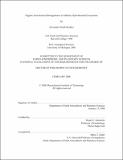| dc.contributor.advisor | Roger E. Summons. | en_US |
| dc.contributor.author | Bradley, Alexander Smith | en_US |
| dc.contributor.other | Massachusetts Institute of Technology. Dept. of Earth, Atmospheric, and Planetary Sciences. | en_US |
| dc.date.accessioned | 2008-11-07T14:10:28Z | |
| dc.date.available | 2008-11-07T14:10:28Z | |
| dc.date.copyright | 2008 | en_US |
| dc.date.issued | 2008 | en_US |
| dc.identifier.uri | http://hdl.handle.net/1721.1/42920 | |
| dc.description | Thesis (Ph. D.)--Massachusetts Institute of Technology, Dept. of Earth, Atmospheric, and Planetary Sciences, 2008. | en_US |
| dc.description | This electronic version was submitted by the student author. The certified thesis is available in the Institute Archives and Special Collections. | en_US |
| dc.description | Includes bibliographical references. | en_US |
| dc.description.abstract | The 13C content of microbial products are controlled by many factors, including the 13C content of the growth substrate, growth rate, the flux of carbon through various parts of the biochemical network, and the isotopic fractionation imposed by the enzymes of that network. We analyzed the 13C content of products of the methanogen Methanosarcina barkeri and found that fractionation varied strongly with substrate availability.These results inform our analysis of methanogen lipids from carbonates of the Lost City Hydrothermal Field. This ultramafic ecosystem produces methane highly enriched in 13C relative to most biotic methane. We find that the 13C enrichment in methanogen lipids is even stronger -- demonstrating that the Methanosarcinales in active vents are methane producers, and that they are likely carbon-limited. Archaea in other parts of the vent field at Lost City are methanotrophs. The application of lipid biomarkers helps unravel the multiple biological and abiotic sources of methane at Lost City.Closer examination of lipids from Lost City shows that most are ether-type glycolipids. The dominance of glycolipids over phospholipids may be a phosphorus-conservation strategy in waters that are likely phosphorus-poor. Ether core lipids are similar to those produced by sulfate-reducing bacteria in environments where methane is oxidized anaerobically. Insoluble residues in Lost City carbonates contain proteinaceous organic material and have end-member d15N values near 0 0/00, suggesting active nitrogen fixation is occurring.Biomass and lipids from Yellowstone hot springs also showed surprising enrichments in 13C. The common factor is high pH; unusual 13C enrichment may be common in alkaline hydrothermal systems.Organisms in terrestrial and marine alkaline hydrothermal systems produced organic carbon with d13C outside of the usual biological range. | en_US |
| dc.description.abstract | (cont) This informs our application of carbon isotopes as biosignatures, and suggests that biological and abiotic organic carbon may sometimes have 13C contents that are indistinguishable. | en_US |
| dc.description.statementofresponsibility | by Alexander Smith Bradley. | en_US |
| dc.format.extent | 269 p. | en_US |
| dc.language.iso | eng | en_US |
| dc.publisher | Massachusetts Institute of Technology | en_US |
| dc.rights | M.I.T. theses are protected by
copyright. They may be viewed from this source for any purpose, but
reproduction or distribution in any format is prohibited without written
permission. See provided URL for inquiries about permission. | en_US |
| dc.rights.uri | http://dspace.mit.edu/handle/1721.1/7582 | en_US |
| dc.subject | Earth, Atmospheric, and Planetary Sciences. | en_US |
| dc.title | Organic geochemical biosignatures in alkaline Hydrothermal ecosystems | en_US |
| dc.type | Thesis | en_US |
| dc.description.degree | Ph.D. | en_US |
| dc.contributor.department | Massachusetts Institute of Technology. Department of Earth, Atmospheric, and Planetary Sciences | |
| dc.identifier.oclc | 247999175 | en_US |
